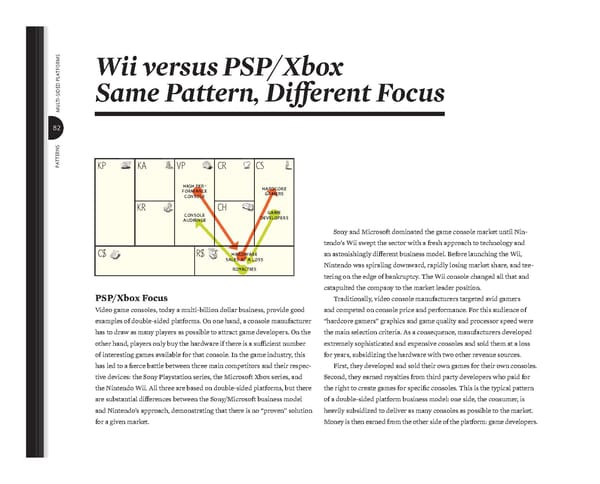82 patterns Multi-sided platforMs Wii versus PSP/ Xbox Same Pattern, DiΩerent Focus PSP/Xbox Focus Video game consoles, today a multi-billion dollar business, provide good examples of double-sided platforms. On one hand, a console manufacturer has to draw as many players as possible to attract game developers. On the other hand, players only buy the hardware if there is a suΩicient number of interesting games available for that console. In the game industry, this has led to a fi erce battle between three main competitors and their respec- tive devices: the Sony Playstation series, the Microsoft Xbox series, and the Nintendo Wii. All three are based on double-sided platforms, but there are substantial diΩerences between the Sony/Microsoft business model and Nintendo’s approach, demonstrating that there is no “proven” solution for a given market. Sony and Microsoft dominated the game console market until Nin- tendo’s Wii swept the sector with a fresh approach to technology and an astonishingly diΩerent business model. Before launching the Wii, Nintendo was spiraling downward, rapidly losing market share, and tee- tering on the edge of bankruptcy. The Wii console changed all that and catapulted the company to the market leader position. Traditionally, video console manufacturers targeted avid gamers and competed on console price and performance. For this audience of “hardcore gamers” graphics and game quality and processor speed were the main selection criteria. As a consequence, manufacturers developed extremely sophisticated and expensive consoles and sold them at a loss for years, subsidizing the hardware with two other revenue sources. First, they developed and sold their own games for their own consoles. Second, they earned royalties from third party developers who paid for the right to create games for specifi c consoles. This is the typical pattern of a double-sided platform business model: one side, the consumer, is heavily subsidized to deliver as many consoles as possible to the market. Money is then earned from the other side of the platform: game developers. high per- formance console console audience hardcore gamers game developers hardware sales at a loss royalties VP CR CH CS KP KA KR R$ C$ gamers developers hardware sales at a loss hardcore gamers console high per- formance console sales at a loss royalties audience developers hardware sales at a loss game developers sales at a loss hardware sales at a loss bmgen_final.indd 82 6/15/10 5:36 PM
 Business Model Generation Flipbook Page 87 Page 89
Business Model Generation Flipbook Page 87 Page 89